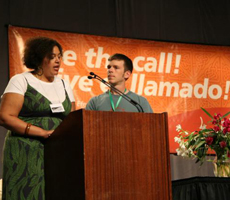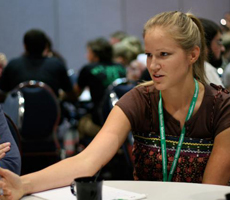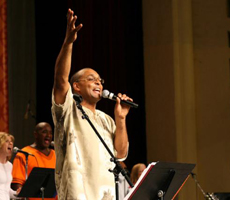Steve Kriss
skriss@mosaicmennonites.org
 We had a good time together in California, the 6,000 or so Mennonites who gathered at San Jose 2007. Youth sang hymns late into the night on the city’s efficient light rail. We heard new Mennonites like Phoenix pastor Shane Hipps tell his story of becoming Anabaptist first in the head, then in the heart. Brother George Makinto from Los Angeles lead the adults with grace and ease in multilingual worship. A team from Eastern Mennonite University produced creative and high quality video for youth and adults all week. It was a time of hopeful interaction.
We had a good time together in California, the 6,000 or so Mennonites who gathered at San Jose 2007. Youth sang hymns late into the night on the city’s efficient light rail. We heard new Mennonites like Phoenix pastor Shane Hipps tell his story of becoming Anabaptist first in the head, then in the heart. Brother George Makinto from Los Angeles lead the adults with grace and ease in multilingual worship. A team from Eastern Mennonite University produced creative and high quality video for youth and adults all week. It was a time of hopeful interaction.
But it was also a sobering week. I was struck by how many of us were white with gray hair. I was the youngest of the ten who sat at my round delegate table. While there were reportedly more young adults present than ever before, I wondered in the midst of our discussion what kind of future our church might have when the average Mennonite is 54 years old. As experienced leaders (all old enough to be my parents and with the departure of moderator Roy Williams, all EuroAmerican and from the Midwest) navigated our delegate discernment, Jim Schrag called for an audacious church. It was a buzzword that sounded more like the word choice of a California surfer than our staid MC USA executive director and it caught the attention of the delegates. What would it take to be an audacious church?
Audacity suggests both boldness and an element of surprise. In listening to Conrad Kanagy’s report about Mennonite Church USA demographics at San Jose, we need to recognize that the research suggests a serious decline. To find a hopeful future, we’ll need to make audacious choices that recognize two things that we heard at San Jose 2007—the rapid growth of African American, African, Asian and Latino congregations and the loss of young adults within the church as a whole.
 The anti-racism reports from denominational agencies thinly mask the embarrassing realities of racial/ethnic tokenism within most of our institutions. Young leaders frequently find themselves on the margins of engagement and decision-making even when present at the table. I am convinced that by opening the church and its institutions beyond token additive presence to persons under 30 and racial/ethnic leaders, we’d find surprising new structures that lean toward relevance, sustainability, and flourishing. We need the creative audacity of those leaders to transform our ways of doing and being into a real future. We need those transformative insights now, not in a decade after the average Mennonite Church USA member is over 65.
The anti-racism reports from denominational agencies thinly mask the embarrassing realities of racial/ethnic tokenism within most of our institutions. Young leaders frequently find themselves on the margins of engagement and decision-making even when present at the table. I am convinced that by opening the church and its institutions beyond token additive presence to persons under 30 and racial/ethnic leaders, we’d find surprising new structures that lean toward relevance, sustainability, and flourishing. We need the creative audacity of those leaders to transform our ways of doing and being into a real future. We need those transformative insights now, not in a decade after the average Mennonite Church USA member is over 65.
I have seen the capacity of audacious leaders. From Philadelphia where my colleague Aldo Siahaan was amazed at what it felt to be part of the larger Mennonite Church USA community for the first time while bridging Anabaptist values to Indonesian immigrants at San Jose, to the call from mostly urban leaders who desire an end to disciplining and expelling congregations because of dissonance with the Confession of Faith in a Mennonite Perspective to San Jose Junior High conventioners who raised $4000 to share with Anabaptists in the Congo.
Audacity assumes that our future begins now, not tomorrow. Our future is not small-town homogeneity but increasing heterogeneity in familiar places as well as vibrant Anabaptist visions from the coasts, borders, and cities. Our lack of recognition of this heterogeneity is already embarrassing. Inadequate language translation as was the case at San Jose 2007 marks us as ill-prepared for the present as well as the future. Reading Scripture and singing occasionally in other languages is not enough to move into our heterogeneous future. We’ll need to be more intentional about how we include those among us who speak not only Spanish but Chinese, Arabic, Korean, Indonesian, Garifuna, French, Vietnamese, Hmong, Cherokee, German, and Amharic.
 Audacity within our denominational structures involves the risk of confronting the limitations of continuing administrative activity from Elkhart and Newton. I cringe at the realization that it seems we’ve already embraced a future for our denomination in which we’re working mostly from small cities in the Midwest, ignoring early MC USA transformation commitments to bi-coastal presences. Have we deemed coastal locations too expensive without counting the costs of a future that ignores urban, multi-ethnic, bi-coastal realities?
Audacity within our denominational structures involves the risk of confronting the limitations of continuing administrative activity from Elkhart and Newton. I cringe at the realization that it seems we’ve already embraced a future for our denomination in which we’re working mostly from small cities in the Midwest, ignoring early MC USA transformation commitments to bi-coastal presences. Have we deemed coastal locations too expensive without counting the costs of a future that ignores urban, multi-ethnic, bi-coastal realities?
Mennonite Church USA institutions are largely bound to tradition and practice that seemingly ignores the deductions of Kanagy’s report. We’re too often stuck asking increasingly irrelevant questions like whether persons are from MC or GC congregations or living in fear of the possibilities of diminished human resources and capital. We make safe, inaudacious choices. Audacity suggests a sense of fearlessness that we don’t often gird ourselves with as process and consensus oriented Mennonites.
At San Jose 2007, we heard good stories and witnessed some difficult facts. These stories and facts suggest both deep needs and wonderful possibilities. I don’t want to incite a doomsaying fear, but invite us to recognize the dream of audacity that we glimpsed in California together. Do we have the courage and wherewithal to be shaped and reshaped by young leaders and leaders from our growing racial/ethnic community? The future of our church depends on this willingness to be transformed now beyond the difficult institutional shuffling that has been our merged denominational history and into new generations and new representations of what it means to boldly live out our calling. Viva el llamado.
Photos by David Landis
The opinions expressed in articles posted on Mosaic’s website are those of the author and may not reflect the official policy of Mosaic Conference. Mosaic is a large conference, crossing ethnicities, geographies, generations, theologies, and politics. Each person can only speak for themselves; no one can represent “the conference.” May God give us the grace to hear what the Spirit is speaking to us through people with whom we disagree and the humility and courage to love one another even when those disagreements can’t be bridged.

That sounds a lot bleaker than I feel, Steve, at least as regards young adult participation. I can see where you’re coming from on the subjects of multiethnic inclusion and the urban/rural spending disparities, though. I’d say that the first question to answer in addressing those issues is whether they arise from leadership priorities (top-down) or from the collective behaviors of individual members (bottom-up).
My suspicion is that they’re bottom-up problems: Leadership might do an okay job of including people from a variety of backgrounds, but as long as the broader church isn’t multiethnic it’s inevitably going to look like tokenism. Likewise, leadership can set up all the urban-focussed projects they want to, but as long as they don’t have active support from the membership (at which level resources are still concentrated in suburban/rural areas) they’re not going to make much headway. I recall one young adult delegate asking the Executive Committee what they were doing to remedy the huge gap between funding for Philadelphia Mennonite School and LMH/Christopher Dock. He acknowledged that without the support it’s had from Lancaster and Franconia, Philly Mennonite wouldn’t exist at all – but there’s still this glaring disparity in funding. And that arises as much from the giving priorities of individual Mennonites as it does from anything the conferences, or MCUSA, can do.
Great Blog! I wasn’t at San Jose, but I think too often that we leave these kinds of events saying “Look at how good we are. We sang songs in Spanish and heard from people who’s last name isn’t even Swiss-German.” It’s kind like what happens in church on Sunday morning, we’re inspired and excited and we see the future… for about two minutes. Then we realize that living that future is hard and we go back to our daily routines.
Living the call you’re talking about is hard work. It means we consistently have to step beyond ourselves, look hard in the mirror and call on God to help us correct what we see. I agree with Jeremy above that this is not (only) the work of MC USA leadership, but the work of MC USA. We keep talking about being missional, well this is it folks. If we can’t reach beyond our upper-middle aged, Euro-American selves to members of our own denomination, we will never be able to reach anyone else.
When I am feeling cynical I think of all the congregations I know who are embroiled in arguments about liberal vs. conservative theology, or accepting women in ministry or homosexuals as members, or are worried about how they’re going to pay off their building. And I wonder how we will ever get beyond ourselves? But then I remember that God is already there, and if we could just figure out how to see even a glimpse of what God sees then maybe, just maybe, we’ll move forward into the the beautiful future you are longing for.